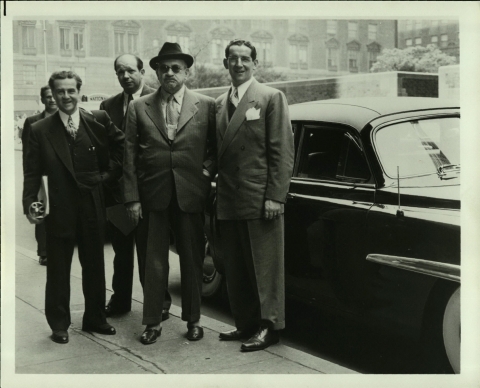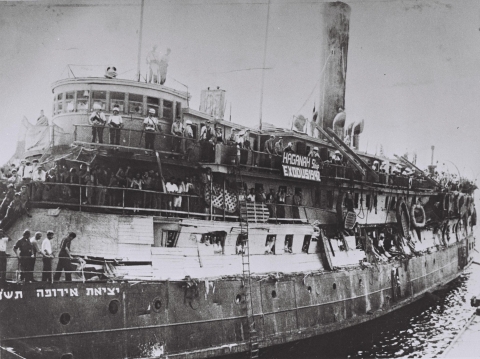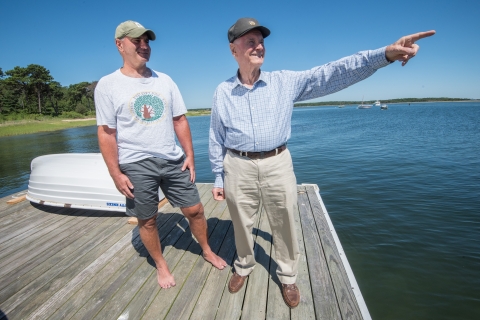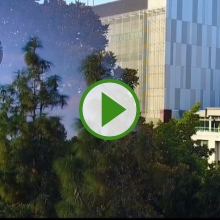A Boston beginning
The Teplows, Dewey Stone, and the origins of the Weizmann Institute
People behind the science

In the depth of winter in 1940, Dr. Chaim Weizmann flew to Boston to garner support for a future Jewish state and raise money for the Sieff Institute, the precursor to the Weizmann Institute of Science. From his perch as head of the World Zionist Organization, he spoke to an audience of Boston Jews about his vision. When the event ended, three men—Dewey Stone, Harry Levine, and Meyer Weisgal—accompanied Dr. Weizmann to his hotel room, where the group brainstormed together until 3 a.m. about specific steps to realize his vision.
There, they hatched a plan for a nucleus of donors from New England to support the Daniel Sieff Institute, to raise the first $5 million from America, and for this group to expand nationwide to what would eventually become the American Committee for the Weizmann Institute of Science. They also discussed specific ways they and their circle of friends would help advance the establishment of the Jewish state, using their political and business ties and their personal wealth.
All three men went on to play key roles in the Institute: Weisgal, a journalist from New York who had published the first English translation of the works of Chaim Nachman Bialik and had already served as head of the Zionist Organization of America, moved to Israel and became Dr. Weizmann’s right-hand man. Harry Levine, who ran a thriving plastics business in Leominster, Massachusetts, committed large sums of his own fortune to the Institute's development. And Dewey Stone, who formally founded the American Committee in 1944, made his first move on behalf of the Institute by purchasing an additional 50 acres for the five-acre Sieff Institute, expanding its reach across the fields and orchards of Rehovot.
The story of Dewey Stone is that of a successful businessman from Brockton, MA, who used his personal fortune, political connections, and special touch to help Dr. Weizmann establish the State of Israel and the Weizmann Institute. He was a “behind-the-scenes mover who wanted the best for his family and for Israel and never sought fame for himself,” says his nephew, Ted Teplow, of Cambridge, MA. Dewey and his wife Anne had no children of their own, but they had 17 nieces and nephews. The Teplow family, led by Ted and his son David Teplow, has advanced the Stone legacy through its own special connection to the Institute.
Ted, who received an honorary doctorate from the Institute in 2002, has served in a series of leadership roles for the American Committee, and David, of Weston, MA, became President of the American Committee last year. The father-son duo are co-chairs of the Weizmann Institute’s Global Gathering taking place in Boston in June. Through their family foundation, they have given generously to the Weizmann Institute in a range of scientific areas—from scholarships and research support to a career development chair and funds for facilities. Their most recent gift supported the renovation of the Stone Administration Building, which was named in honor of Dewey Stone in 1966.
“Few individuals have had such a profound influence on laying the very foundations of the Weizmann Institute as Dewey Stone,” says Weizmann Institute President Prof. Daniel Zajfman. “And the Teplow family has carried his torch forward, ensuring through their generosity and friendship that his legacy and that of the Teplow family will remain an important piece of the Institute for years to come.”
“Dewey became enamored by the vision of Chaim Weizmann, and took it on as his own personal mission,” says Ted. “Because he and Anne had no children, I have always felt my task in life was to keep my uncle’s life story alive. What he did was exceptional, and he mustn’t be forgotten.”
The man who always asked: ‘Do you need anything?’
Dewey Stone was born in 1900 in Brockton, then a poor migrant town. He ran a series of thriving textile and other businesses, and installed his nephews at the helm of many of them. The most well-known among the companies was Converse Rubber Co., maker of raincoats and shoes and later, most famously, Chuck Taylor All-Star sneakers. “He always had a phone on each ear, managing his many businesses and multitasking,” recalls Ted.
He was also extraordinarily generous with his family members. “Dewey would end every phone conversation with his relatives with the question, ‘Do you need anything? Do you want anything?” says Ted. He had a gift for forming close personal relationships, which served every aspect of his life. “He was a great success as a fundraiser because he would sit you down, connect with you, and go on to tell you how much you are going to give, whom you are going to give it to, and when to give—and everyone listened.”
That cold January night spent with Dr. Weizmann, Levine, and Weisgal was a turning point in Stone’s life. Years later, Stone reflected on that moment in writing. “What Dr. Weizmann said that evening in Boston stayed with me throughout the decades: ‘Our Palestine can never compete with the United States Steel Corporation or General Motors and the making of cars, but in the quality of its human material. In creativity, in arts and science, the Jewish people of Palestine, given the opportunity, will match all other nations and bring joy and pride to Jews throughout the world.’”
On that Boston visit, Stone took Dr. Weizmann on a drive along the banks of Charles River, from Boston to Cambridge, so that he could see Harvard University. On the way, they passed MIT. “At his request,” Stone later wrote, “I stopped the car, and he looked long and longingly at [MIT’s] new buildings. As he gazed at them, I knew he was thinking of Palestine and what might be done if research facilities like these existed there. It was at that moment that the seed of hope that this dream might really be achieved was planted in me, sitting in a stationary car with a silent visionary.”
Stone and Levine assumed a central role in the clandestine activities of the Haganah, the Jewish underground, including the acquisition of 10 boats to ferry European refugees to Palestine. The friends purchased surplus U.S. military equipment, which they secretly shipped to Palestine. Levine acquired arms and ammunition, and Stone, through his Weston Trading Company, funded the purchase of the boats, including the famed Exodus.
Aware that the FBI was tapping his phone, Stone often made calls from the home of his sister Evelyn. “He bought the Exodus on my mother’s telephone,” recalls Ted.
The fate of the Exodus—attacked by the British as it neared the shores of Palestine and its passengers returned to camps in Germany—marked a turning point in the international sympathy for the establishment of a Jewish state, and soon afterwards, the UN agreed to vote on partitioning Palestine between the Jews and the Arabs. But Stone’s work had just begun: he was also instrumental in securing the vote for the Partition Plan in November 1947. He and his brother, Harry Stone, a judge, had become friendly with the Nicaraguan dictator, Anastasio Somoza, when he came to Boston for surgery in the 1930s. As the clock ticked down to the UN vote, the brothers asked Samoza to generate support among other Latin American countries for the future Jewish state. It worked, and 13 Latin American countries voted in favor, bringing the final count to 33-13 and helping secure the partition.
Truman’s about-face
A few months later, in early 1948, President Harry Truman, under increasing pressure from the State Department, decided to reconsider his policy about the creation of a Jewish state—even going so far as closing off the White House to Zionists. With the expiration of the British Mandate nearing, Dr. Weizmann flew to New York in March in a last-minute attempt to meet with Truman, to ask him to reinstate his support for the partition, but the President wouldn’t meet with him. Dr. Weizmann expressed his frustration to Stone, who returned to Boston, despondent.
That night, Stone connected with Eddie Jacobson, Truman’s former business partner in Independence, Missouri. Eager to help, Jacobson traveled to Washington and asked the President for a first and only favor: a few minutes of his time in the Oval Office.
The meeting was successful, and Truman agreed that Dr. Weizmann could visit him at the White House—albeit through the side door. The two had a long meeting, and Truman did an about-face, agreeing to recognize Israel. The presidential recognition of the Jewish state gave the Jewish leadership in Palestine the green light to declare independence, which it did on May 14.
Stone continued to work toward fully actualizing Dr. Weizmann’s dream. After Israel’s establishment, Stone visited Prime Minister David Ben-Gurion, and suggested that Israel raise money for development and immigrant absorption through issuing bonds; Israel Bonds eventually raised more than a billion dollars for Israel’s fledgling economy. Stone went on to serve in many leadership and fundraising roles in Israel’s early development.
He devoted his greatest time and resources, however, to the Sieff Institute, and it became “his number-one philanthropic priority,” says Ted.
In November 1949, the Weizmann Institute of Science was inaugurated. Stone became the founding Chair of the Weizmann Institute’s Board of Governors.
When Stone retired from the Board of Governors in 1970, the Institute threw him a grand farewell party, which honored Harry Levin as well. Golda Meir spoke. “I don’t know a thing that was done in Israel of value, of importance, that these two… boys didn’t have a hand in,” she said. “I don’t know if they worry about their business. About Israel they worry. About Israel they do everything they can. There are some things that still cannot be told... Someday somebody, I hope, will tell it.”
When Stone died in 1977, Meir said, “No American Jew did more for Israel.”
A homecoming
Ted Teplow was born in 1928 in Brockton and graduated from the Merchant Marine Academy, then went on to get his MBA at Harvard Business School. He and his wife Charlotte had five children. He had been all over the world in the U.S. Merchant Marine, which offered him familiarity with the rules of commerce in many countries. So when his uncle installed him and his cousin Hugh Stone as heads of Crosby Valve Co., a maker of safety valves for nuclear reactors, it felt natural to expand his business globally. The company gained a near-monopoly on the market, and its biggest clients were General Electric, Westinghouse, and the U.S. Navy.
Crosby was acquired in 1980 and Ted served as a consultant to the company for 19 years. The employee stock ownership program he and his cousin Hugh created led to a substantial windfall upon Crosby’s sale for each of the employees—including several mentally and physically disabled men and women who lived in a nearby institution and whom he employed in whatever capacity they could manage.
For David Teplow, the Weizmann Institute has been a natural attraction that goes beyond his family’s connection. “I was always interested in math and applied math, which is why I went into computers,” he says. “Weizmann has three Turing Award winners. They are rock stars to me.” David, a Dartmouth alum who studied computers with some of the field’s pioneers in the late 1970s, founded two database companies that became market leaders, Database Technologies and Integra Technology Consulting, which is focused on big data.
Ted says he is looking forward to the completion of the Stone Building renovation as eagerly as the President and Vice Presidents, whose offices will be housed there. “Every time I am on campus and I look at the Stone Building, I realize this is something that will outlast us,” says Ted. “And it will keep the Stone name recognized.”
The symbolism of hosting the next major Weizmann Institute gathering—on the 75th anniversary of the establishment of the American Committee—isn’t lost on the father-son duo. “Having the Global Gathering in Boston is like a homecoming,” says David. “This is where it all began.”

Dewey Stone (at left) with Dr. Chaim Weizmann (center) and Victor Potamkin, who brought Dr. Weizmann the Lincoln car

The famed Exodus immigrant ship was funded by Dewey Stone

David and Ted Teplow








